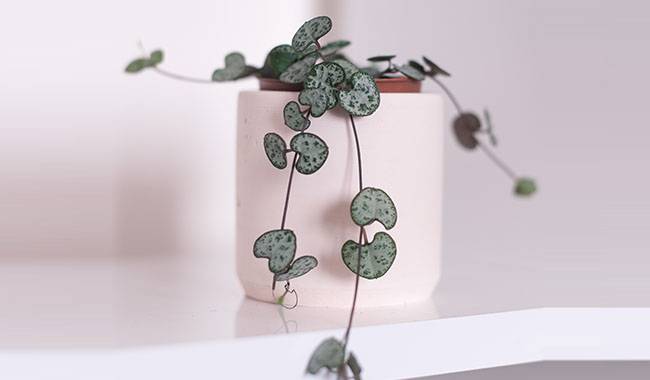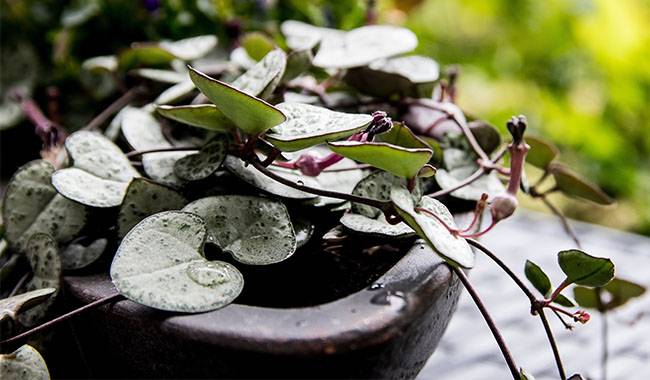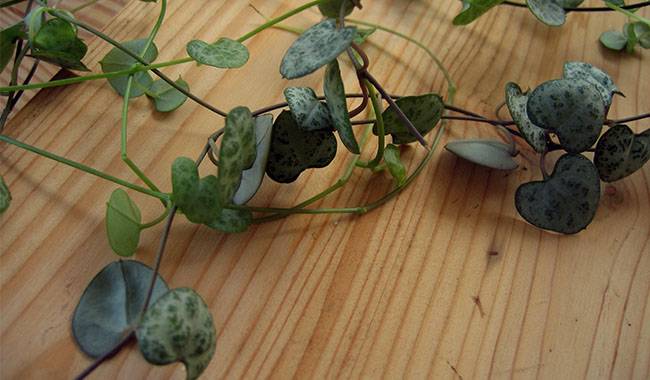
Among indoor tuber crops, it is rare to find plants with pendulous, filamentous shoots that grow in an ampelike form. Ceropegia’s is one such “exclusive” plant. But it is considered one of the most primitive plants, and not just because of its growth form. Ceropegia’s fleshy metallic leaves make it look like a miracle in itself. And when the plant blooms, its candelabra-like flowers turn it into an alien in the house. Ceropegia’s extravagant appearance is combined with its unpretentiousness. And how can one resist such a combination? You will learn How to Grow and Care for Ceropegia at Home in the ThumbGarden article.
CEROPEGIA PLANT DESCRIPTION
Ceropegias are a very original representative of indoor succulents. Vining and perennial herbs belonging to the genus Ceropegia with their surprisingly tuberous, single-toothed rhizomes. They look as if they want to impress with every feature – from their roots to their flowers. In nature, Ceropegias are found mainly in Africa and are a striking part of the flora of Madagascar and New Guinea.
Ceropegias are permanent ornamental herbaceous perennials. The large tuberous rhizomes, which eventually become woody, produce several thread-like hanging stems. They are prostrate, thickened at the nodes, and have little or no branching.
The leaves are arranged at the nodes and reach only 1 inch (2.5 cm) in diameter, always sitting relatively on a rather elegant petiole. Their kidney or heart shape (ovate in some species and cultivars) is easily recognizable, as is their fleshy and thickened texture. The leaves are always solid, with a pale green color above, with silver, bronze, steel, or purple spots coming through.
The metallic color of the upper part of the leaf is accentuated by the pink color of the underside. Small tubercles often form in the axils of the leaves. These leaves look like fancy ornaments strung on a string.
Ceropegia flowers are no less original. Pot-shaped, exotic flowers with swollen, spotted bottoms up to 1 inch (2.5 cm) long open in the leaf axils. The pink, green or light purple “spotted” colors only emphasize the unusual structure, reminiscent of lanterns and candles.
TYPES OF INDOOR CEROPEGIA PLANTS
Of the 150 species of wild Ceropegia, only a few special plants are popular in culture, and only two species are popular as houseplants.
Wood’s Ceropegia (Ceropegia woodii) is the most common species of Ceropegia, with tuberous rhizomes, slender stems, and bud-like leaves.
Ceropegia creeping or Ceropegia sandersonii is a more capricious, large-flowered species with mottled flowers and thickened, curved shoots.
GROWING CONDITIONS FOR INDOOR CEROPEGIAS PLANTS

Light and Air
Ceropegias prefer to grow in bright light. They are comfortable in south-facing and partly south-facing windows and prefer soft sunlight. Even summer afternoons can be dangerous for them if the temperature is very high and there is no fresh air.
Lack of light affects the shape of the buds and the size of the leaves. In order to have almost uninterrupted flowering from autumn onwards, the plants need to be given supplementary light or moved into the light.
Temperature and ventilation
Ceropegias prefer a drop in temperature at night (but not a sudden jump from “average” conditions) and are usually fine indoors where popular Ceropegia is located. In rooms, they will prefer cooler, 68-73 °F (20-23°C), rather than hot. However, with regular ventilation, they will tolerate all temperatures. Cool, light-colored rooms, with temperatures measuring between 53-60 °F (12-16°C) – as low as 50 °F (10 degrees), are considered ideal for Ceropegia overwintering.
During the summer months, the plant can be placed outdoors. When growing Ceropegia, regular ventilation is a must.
HOW TO TAKE CARE OF CEROPEGIAS PLANTS AT HOME

Watering
Ceropegias prefer bottom watering, as even water drops on the tubers can cause rot, but a careful program will also allow classic top watering. Ceropegias prefer steady light moisture and should allow the soil to dry out at the top and partly in the middle layer and should not allow water to accumulate in the tray. Watering should vary according to the developmental stage of the plant.
During vigorous growth, germination, and flowering, Ceropegia requires moderate to medium watering. However, after flowering, it is best to reduce the amount of water by drying the substrate more. Too much watering, even if only once, can kill the plant. Only warm, soft water is suitable for Ceropegias.
Ceropegias do not like humidity and tolerate dry air well with regular ventilation. In extremely dry air they will not resist the installation of trays with peat or pebbles to create a stable environment or a careful spray of fine mist, provided there has been a very hot overwintering period. Spraying has also been used as an incentive to release buds after a dormant period.
Fertilization
For panicles, especially those that maintain comfortable cool conditions during the winter, fertilization is usually done only between flowering periods. Regular but moderate fertilization from March to the end of September is considered to be the best strategy for this plant. Its frequency is twice a month, but the amount of fertilizer is reduced by half. In the first year after transplanting, fertilization is not required.
Pests
If the leaves fall off, the buds become bare, or the plant loses its ornamental qualities, the stems can be safely cut back as it will produce some younger plants to replace them. It is customary to replace plants every five years with new plants grown from cuttings.
These fancy amphioxuses are often plagued by mealybugs and aphids. These insects can only be controlled with biocides or insecticides. Ceropegias may suffer from spider mites if kept in very dry air, or if the collection is infested with insects. But this pest can be controlled by simply washing the leaves and shoots.
TRANSPLANTS, CONTAINERS, AND SUBSTRATES FOR CEROPEGIA
This plant is transplanted in February or March, as needed, using growth as a guide. Small containers suitable for tubers or family size – 1-2 inches (2.5-5 cm) from the wall should be compact for Ceropegia. Ceropegia can be grown with other succulents to form complex combinations.
Ceropegias need to be grown in a very light, breathable soil of choice, without the slightest risk of compaction. A special succulent substrate with added leaf soil or a general-purpose substrate with at least a third of loosener and sand is ideal for them. The optimal pH is between 4.5 and 6.0.
High drainage and large drainage holes are a must for Ceropegias. Transplanting should be done while maintaining the same level of submergence. The root ball should not be broken and the plants should be moved very carefully.
HOW TO PROPAGATE CEROPEGIA PLANTS
New Ceropegia can be obtained from aerial tubers that are gently pressed into the soil and germinated under a warm canopy. However, a more popular option is to fix the shoots in small pots or to take root tips and stem cuttings.
Taking cuttings from this plant does not require any special skills: the tip or branch with 2-3 internodes, preferably also with airy nodules, is placed in a “ring” on the soil, which connects the nodules to the substrate. The cuttings are oriented upwards to prevent them from sinking into the soil.
For rooting, it is enough to keep the substrate slightly moist. After rooting, either tubers or cuttings can be propagated by 2-5 plants per pot, following the standard rules for wide and shallow containers. Ceropegia can also be propagated by division, cutting off long shoots to speed up the rooting of the separated parts.







